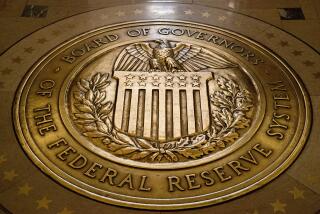Fed’s ‘beige book’ shows the cost of policy uncertainty
WASHINGTON -- If there was any doubt about whether uncertainty has a real cost to the country, the latest Federal Reserve summary of the economy should dispel that.
Over and over again, the so-called beige book -- an anecdotal account of the economic conditions in each of the Fed’s 12 districts -- talks about the drag caused by the heightened uncertainty over the government’s budget and debt-ceiling crisis.
The report, released Wednesday, describes the overall economy as growing at a “modest to moderate pace” during September and early October, similar to the previous period. But the uncertainty about the political and economic landscape, including interest rates and how the healthcare law will play out, factored more significantly in the latest report.
Consider what they said: Manufacturers in the Cleveland district won’t build additional capacity for production, even though they say it is needed. The San Francisco district’s defense industry sees a reduction of new orders and revenue. There’s increased market volatility in Chicago. Commercial real estate businesses in Boston are planning for weaker activity.
For workers, all this translated into less hiring in the last two months. The beige book -- which is based on interviews with key business people, economists and market experts, among others -- said that employers in several districts “were cautious to expand payrolls.” The reason they gave: uncertainty.
On the bright side, the latest beige book showed the uncertainty over the European debt crisis had eased considerably; some said that the “European risk has been ‘priced in’ or forgotten about.”
And the overall outlook for the economy appears to be one of cautious optimism, with most districts expecting the economy to build on the modest gains in consumer and business spending, as well as hiring.
There’s also optimism that the political impasse in Washington will soon end, after the Senate reached a deal Wednesday to reopen the government and raise the debt ceiling.
Still, analysts worry that lawmakers in the end will only be putting a Band-Aid over the problem.
“Once the initial euphoria has worn off, however, we suspect that investors will begin to focus on the short-term nature of the deal, which means that another shutdown is possible early in the new year,” said Paul Ashworth, an analyst at Capital Economics. And that, he said, will still leave plenty of uncertainty.
ALSO:
White House: Government is nearing a ‘cash-on-hand situation’
A government shutdown could hurt economy more now than it did in 1995
Can U.S. prioritize payments as default looms? Many are dubious







